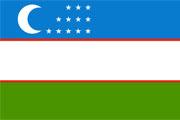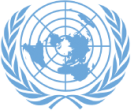General information about the Republic of Uzbekistan
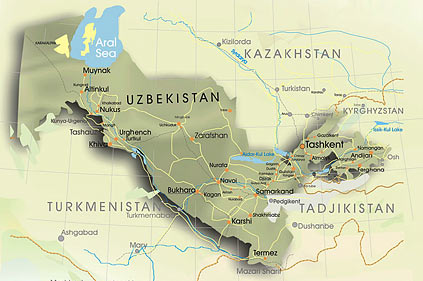 The Republic of Uzbekistan is situated in Central Asia, and covers an area of 448.9 thousand sq. km. The length of the territory of the Republic from west to east is 1 425 km from north to south - 930 km.
The Republic of Uzbekistan is situated in Central Asia, and covers an area of 448.9 thousand sq. km. The length of the territory of the Republic from west to east is 1 425 km from north to south - 930 km.
The territory in the north and north-east of the Rebublic of Uzbekistan borders with Kazakhstan, in the east and south-east with Kyrgyzstan and Tajikistan in the west with Turkmenistan, in the south with Afghanistan. The total length of the country border is 6221 km. The long border with Afghanistan is 137 km, with Kazakhstan - 2203 km, with Kyrgyzstan - 1099 km, with Tajikistan - 1161 km and Turkmenistan - 1621 km (administrative-territorial structure of the Republic of Uzbekistan).
The Republic of Uzbekistan declared September 1, 1991 the Day of Independence. The Republic has diplomatic relations are established with 134 countries. The embassies of 45 countries and many foreign organizations have set up their offices in Tashkent.
Regions
Uzbekistan has 13 regions (provinces), bordering Kazakhstan in the north, Kyrgyzstan and Tadjikistan in the east, Turkmenistan in the west and Afghanistan in the south.
-
Andijan
-
Bukhara
-
Djizzak
-
Fergana
-
Kashkadarya
-
Khorezm
-
Namangan
-
Navoi
-
Samarkand
-
Surkhandarya
-
Syrdarya
-
Tashkent
-
Republic of Karakalpakistan
National Holidays
Day of defenders of the Native land (January, 14th)
This holiday in independent Uzbekistan is celebrated in honor of creation of national Armed forces. Parliament of the country on January 14, 1992 made a decision on transfering all units, military educational institutions and other military formations deployed in territory of the country, under jurisdiction of the Republic of Uzbekistan. So, it laid the foundation for establishing national Armed forces. On December 29, 1993 "January 14" has been declared as the Day of defenders of the Native land.
Women's day (March, 8th)
In Uzbekistan this holiday is celebrated as a holiday of love, kindness and beauty, as well as it is known as "Mothers' day".
Navruz (March, 21st)
The most ancient national holiday Navruz (in translation with Persian Navruz means"new day") which is celebrated on March, 21st, is considered the beginning of new year. As is known, March 21st is a day a spring equinox. Day length and nights is identical - 12 hours. In the beginning of this holiday many Uzbek families prepare for national dishes such as Sumalak, Halim, Somsa from plant, Plov and others. These Uzbek dishes contain many vitamin substances which are useful to a human body.
With the obtaining of the country's independence ancient customs and traditions of Uzbek people have revived, holiday Navruz also has been restored, and celebrating has got new scope and depth. It became a national holiday of friendship, unification, brotherhood of all people. In the bright dramatized representations of philosophic and poetic judgment of Navruz, it places in national history reveals. Now Navruz is celebrating annually in a grand manner.
Day of memory and honor (May, 9th)
In 1999 majestic Square of Memory has been opened in capital of Uzbekistan on 9th May and since then Day of memory and honor on May, 9th is celebrated. This holiday in independent Uzbekistan is celebrated in honor of memory of our compatriots which during centuries heroically, self-denyingly protected our native territory, its freedom and independence, a peace life of our people. Also this holiday is considered as a day of honoring human being, in this day people check up on their relatives and friends, particularly the elderly are honored and visited.
Day of independence (September, 1st)
The main national holiday of the Republic of Uzbekistan is the Day Independence. This holiday is celebrated annually on the 1st September, is ceremonial and colorful. This national holiday personifies all dreams and expectations of all Uzbek people which lean on main principles friendliness, solidarity, charity, mutual respect.
Representatives of the various nations living in Uzbekistan, despite of a nationality, religion, the social status all actively celebrate a holiday in each street, the area and the people living in mahallas and in regions.
Day of teachers and educators (October, 1st)
Annually the Day of Teachers and Instructors is solemnly celebrated in Uzbekistan. The deep respect for the teacher has taken roots in our territory during old times. "Domlo", "Muallim", "Ustoz" - these words during many centuries with gratitude and respect the pupils received from the teachers not only knowledge on subject matters said, but also lessons about the valid attitude to people, love to the Native land, about high morals and spirituality.
Pupils of schools and educational institutions deeply esteem all those who have given them the first vital knowledge. This day pupils with gratitude give flowers and gifts.
The Constitution Day (December, 8th)
The constitution of the Republic of Uzbekistan is accepted by the Oliy Majlis (Parliament) on 8th December, 1992. This holiday is celebrated across all Uzbekistan.
Ramadan Hayit
This holiday is known as Ruza Hayit, it coincides with 9-th month (Hidjriy) on a Muslim calendar. This holiday includes religious practice as Ruza which lasts 30 days and it is considered a ceremony of spiritual and moral purification. Conditions of the ceremony is the following: from sunrise up to decline not to eat food and also water; will be kept from evil thoughts, assumptions; with all surrounding to be in respect and make whenever possible more than goods to associates.
After performance of this ceremony last day the holiday which lasts three days - Ramadan Hayit begins. The first day of a holiday «Ramadan Hayit» is considered not working day.
Qurbon Hayit
Religious holiday Qurbon Hayit this is the one of the greatest holidays in the World which is celebrated by Moslems. Sources of this holiday are ancient histories which are connected with prophet Ibrohim who in honor of the belief wished to sacrifice to "Allah" of the own son, but kind spirits have stopped his actions and instead of this have told to him to sacrifice animals such as sheep, camels, etc. The holiday lasts three days and these days all Moslems celebrate this holiday with their family with natives and close. Especially in these holidays people visit native and close, and also sick and requiring in the help. The first day of «Qurbon Hayit» is considered not off day.
Culture of Uzbekistan
Culture of Uzbekistan is one of the brightest and original cultures of East. It is inimitable national music, dances and painting, unique national kitchen and clothes. The Uzbek national music is characterized as variety of subjects and genres. The songs and tool plays according to their functions and forms of usage can be divided into two groups: performed in the certain time and under the certain circumstances and performed at any time. The songs connected with customs and traditions, labor processes, various ceremonies, dramatized entertainment representations and games belong to the first group.
The Uzbek people is well-known for its songs. Koshuk — household song with a small diapason melody, covering one or two rows of the poetic text. The dancing character of a melody of this genre provides their performance in support of comic dances. «Lapar» is a dialogue-song. In some areas the term — lapar is applied to wedding songs «Ulan» (which is performed as a dialogue of man and women). Genre «yalla» includes two kinds of songs: a melody of a narrow range, and solo simultaneously with dance. National and professional poems of the poets of East are used as the texts for the songs. The special place in the Uzbek musical heritage occupy «dastans» (epic legends with lyric-heroic content). Also «Makoms»- are the basic classical fund of professional music of oral tradition.
The dances of uzbeks distinguish softness, smoothness and expressiveness of movements, easy sliding step, original movements on a place and on a circle.
The development of national painting began many centuries ago. At 16–17 centuries art of the manuscript and binding in Bukhara and some other urban centers has achieved significant success. The decorating of manuscript included refined calligraphy, performance by water paints and thin ornaments on fields. In Samarkand and especially in Bukhara the Central Asian school of a miniature has achieved a great success and were developed many different style directions. One of them, for example is connected with traditions of Behzod, which characterized with its gentle style of writing the letter and architectural elements.
National clothes
The Uzbek national clothes of the end of XX centuries remain constant up these days. The men in that time carried a direct cover shirts, bottom and top dressing gowns. The dressing gowns were very light and made from cotton wool. There were cuts on each side of dressing gown for convenience at walking. The trousers were made wide, of direct breed lent from top to bottom. Female clothes: dressing gowns, dress.
Uzbek men’s clothing: The basis of national men’s suit is a chapan, the quilted robe, tied with a kerchief. Traditional men’s cap is tubeteika. Kuylak is the men’s straight cut undershirt. Ishton is men’s wide trousers, narrowed at ankles. Traditional footwear is high-boots, made of thin leather. Shirts were worn everywhere, but men from the Fergana Valley and Tashkent region wear a yakhtak, a wrap shirt. Both of these types were sewn from homespun cotton cloth and feature a moderate aesthetics in a form of a decorated miniature braiding- jiyak, stitched along the collar.
Belts for gala dresses were normally very smart, made of velvet or embroidered, with silver figured metal plates and buckles. Everyday shirts are tied with long sashes.
Women's Clothing:
Women's traditional dress consisted of a tunic, pants, a scarf, and a coat. The long, loose tunic had wide sleeves reaching to the wrists. Loose-cut pants were often made of the same fabric as the tunic, or out of complementary fabric. The bottom of the pants was gathered and decorated with embroidered braid. Women's coats were similar to men's khalat.
For centuries cotton has been used extensively for clothing in Uzbekistan. Home-woven striped and white cotton were the most common fabrics for everyday wear. Textile patterns often included up to six or seven different colors in the typical geometrical or stylized floral design. Fabrics were brightly colored, in shades of red, yellow, blue, green, violet, and orange. The color of the costume was an important signal of a person's age or social status. Red and pink were common for girls and young women; middle-aged women were supposed to wear shades of light blue and gray. White was the most popular color and appropriate for all ages, especially for the elderly. Black, dark blue, and violet were colors of mourning.
Women and Men’s national headwear. Tubeteikas (Skull-caps):
Headdress is one of the main elements in the traditional Uzbek clothing. The national headwear in many countries of Central Asia, including Uzbekistan is a tubeteika (skull-cap). Tubeteika is derived from the Turkic word “tubé”, which means “top, peak”. Tubeteika is worn by everybody: men, women, and children. Only elder women do not wear tubeteikas.
Today it is uncommon to meet a man in the tubeteika in large cities, mainly it is an important element of holiday garments at family parties and religious celebrations. The common form of the Uzbek tubeteika is tetrahedral and slightly conical. Traditional men’s tubeteika is black and embroidered with a inwrought white pattern in a form of four “paprikas” and 16 miniature arches. An everyday tubeteika, “kalampir”, is one of the simplest and widely used cap, it’s importance must not be underestimated. This tubeteika is an essential attribute for some events even in the environment of a country-wide influence of the European culture. There are smart tubeteikas enriched with bright and colorful embroideries and patterns for special festival occasions.
Cuisine
Uzbek cuisine is one of the most colorful of Oriental Cuisines. You will get astounded to find some of Uzbek recipes to be centuries-old. They even have different traditional rituals and ways of cooking. There are about 1,000 different dishes including national drinks, cakes and confectionary products.
Uzbek «Pilaf» is a very solemn food. It can be considered as an everyday dish as well as a dish for solemn and great events like weddings, parties and holidays. Rice is the most important ingredient of pilaf and special spices, raisins, or peas will be added to give it extra flavor. However, locals believe that the best pilaf is always prepared by a man! Salads are also served along with pilaf.
Bread is holy for Uzbek people. This traditional belief started with a legend. As it goes, each new Governor would mint his own coins but the payment for local people who minted new coins were not the coins that were minted but…bread!
Traditionally Uzbek breads are baked inside the stoves made of clay called «Tandyr». These fragrant breads are known to be crispy and tasty. Even the greatest scientist of medicine, Avicenna used Uzbek bread to cure people of diseases.
A special importance is placed on soups. Uzbek soup is rich in vegetables and seasonings and contains lots of carrots, turnips, onions and greens. Two popular soups are Mastava and Shurpa.
Traditional Uzbek dance: arts and schools of Uzbek dance
National Uzbek dance is very expressive. It presents all the beauty of nation. The main difference of Uzbek dance from dances of other Eastern nations is the accent on complicated and expressive hand gestures and animated facial expressions. Uzbek dance includes two categories: classic traditional dance and folklore dance.
Classic traditional Uzbek dance is the art, studied in choreographic schools and demonstrated on a stage. There are three schools of Uzbek dance: Ferghana, Bukhara and Khorezm. Ferghana dances are differed with softness, smoothness and expressiveness of gestures, light sliding step, original motions. Bukhara dance is distinguished with sharpness of gestures, leaned back shoulders and very beautiful goldwork costumes. Khorezm style differs with original and distinctive motions.
Folk Uzbek dance includes traditions of almost any region and displays wonderful variety. People dance them on weddings and family holidays, rural and urban events. These dances are handed over from generation to generation and preserve ancient dance traditions as well as today and past lifestyles.
Handicrafts
Culture, handicrafts and tourism are rapidly becoming inseparable partners. Local crafts are important elements of culture, and people travel to see and experience other cultures, traditions and ways of living. Crafts products form an important element of the purchases made by tourists, providing an important economic input to the local economy.
Applied art of Uzbeks has a wealth of variety when it comes to style, materials and ornamentation. Silk, ceramics and cotton weaving, stone and wood carving, metal engraving, leather stamping, calligraphy and miniature painting are some genres passed down from ancient times. Back in the past, each region had its own cultural and ethnic traditions the unique features of which were established by local guilds that have strengthened these characteristics through their art.
Uzbek craftsmen nowadays still practice ancient jewellery making techniques for cutting gemstones, grain filigree, granular work, engraving and enameling, also they are trying to take into account fashion demands and styles.
Embroidery is one of the most popular trends of applied arts in Uzbekistan. Every city of Uzbekistan has its own unique features such as ornamentation, composition, color range and stitching. The finest kind of embroidery, gold embroidery is still practiced in Bukhara.
The art of carpet weaving is also a very ancient form of art throughout Asia and the East, and nowadays it can be found in some of the cities of Uzbekistan today. The art of wood carving is used and adapted in modern interior design. Carved and painted tables, stools, caskets, pencil boxes and bookstands are popular pieces of furniture among local people and tourists. The art of Miniature painting and calligraphy has been revived again in its traditional form as well as some modern variants. For example miniatures stamped on leather, painted on paper miniatures, small lacquered boxes, framed pictures, pencil boxes and many other ideas skillfully painted by masters can be found in Uzbekistan.
President of the Republic of Uzbekistan
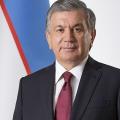 Shavkat Mirziyoyev was born on July 24, 1957 in Zaamin District of Jizzakh Region to a family of doctors. He is an Uzbek by nationality, with higher education. In 1981 he graduated from the Tashkent Institute of Engineers of Irrigation and Mechanization of Agriculture and earned a degree in mechanical engineering. He holds a Ph.D. in Technical Sciences, Associate Professor.
Shavkat Mirziyoyev was born on July 24, 1957 in Zaamin District of Jizzakh Region to a family of doctors. He is an Uzbek by nationality, with higher education. In 1981 he graduated from the Tashkent Institute of Engineers of Irrigation and Mechanization of Agriculture and earned a degree in mechanical engineering. He holds a Ph.D. in Technical Sciences, Associate Professor.
Shavkat Mirziyoyev started his career in 1981 at the Tashkent Institute of Engineers of Irrigation and Mechanization of Agriculture, where he served as a junior research fellow, senior lecturer, associate professor, and the vice rector for academic affairs.
In 1990 he was elected deputy of the Supreme Council of the republic. He served as Chairman of the Credentials Committee.
In 1992 Shavkat Mirziyoyev was appointed khokim (governor) of Mirzo Ulugbek District of the city of Tashkent. In 1996-2001 he served as khokim of Jizzakh Region, in 2001-2003 - khokim of Samarkand Region, and made a great contribution to the socio-economic development of the aforementioned district and the regions.
While working in the executive branch and at the same time as deputy of the Oliy Majlis of the Republic of Uzbekistan in 1995-2003, he has actively and fruitfully participated in the elaboration and adoption of important legislative acts on political and socio-economic development of the country and implementation of democratic reforms.
Shavkat Mirziyoyev was approved as the Prime Minister of the Republic of Uzbekistan in 2003, and three times (in 2005, 2010 and 2015) was approved again in his post by both Chambers of the Oliy Majlis.
From the early years of our Motherland’s Independence Shavkat Mirziyoyev earned a high trust of the first President of Uzbekistan Islam Karimov, by selflessly working as his colleague and close associate.
As head of the Government, he has shown tremendous abilities and outstanding leadership in implementation of wide-ranging socio-economic reforms, modernization and improvement of the country, realization of major and unique projects, development and protection of private property, radical increase in the share of small business and private enterprise in the economy and consolidation of their legal security.
In his activities Shavkat Mirziyoyev attached a special significance to economic development on the industrial basis, improvement of the country’s exporting potential, cardinal transformation of the agricultural sector, especially the extensive advancement of farming enterprise, profound processing of agricultural products, provision for food security of the nation and the guaranteed supply of goods to the population at reasonable prices.
In order to drastically uplift the living and working conditions of people, Shavkat Mirziyoyev took effective measures for large-scale construction and improvement works in all regions of the country, to improve the quality of public services, integrated development of cities and districts, including the remote rural areas.
In his activities, along with socio-economic dimension, a significant emphasis is placed – as a priority focus – on the progress of education, science and healthcare in accordance with modern requirements, creation of conditions necessary for the formation of healthy and comprehensively advanced younger generation, protection of motherhood and childhood.
He has paid much attention to further enhancement of the credibility of the unique institution of self-government – makhalla, other social organizations, consistent consolidation of their role in the community through broad involvement in the process of democratic reforms, as well as the preservation and enrichment of national spiritual values.
Along with this, in addressing the economic and social issues Shavkat Mirziyoyev directly supervised the efforts to build up comprehensive mutually beneficial cooperation with other countries, international organizations and financial institutions, as well as important agreements that serve the national interests and economic development of the country.
On September 8, 2016, on the basis of a joint resolution of the Legislative Chamber (Lower House) and Senate of the Oliy Majlis (parliament) of Uzbekistan adopted at the joint session, Prime Minister Shavkat Mirziyoyev was temporarily assigned the duties and powers of the President of the Republic of Uzbekistan.
On October 19, 2016 the Movement of Entrepreneurs and Businessmen — Liberal- Democratic Party of Uzbekistan (UzLiDeP) during its Eighths Convention in Tashkent nominated the member of Political Council of the Party Shavkat Mirziyoyev as its candidate for the presidential elections.
Shavkat Mirziyoyev was elected President of the Republic of Uzbekistan with 88,61 percent of the vote based on the results of the presidential elections that took place on December 4, 2016. Shavkat Mirziyoyev officially assumed the post of the President of the Republic of Uzbekistan on December 14, 2016.
Shavkat Mirziyoyev is married; with two daughters, one son and five grandchildren. His spouse, Z.M. Mirziyoyeva, has a qualification of an engineer-economist. At present, she is a housewife.
In recognition of many years of productive work in the Government and management, enormous contribution to the development of the country, improvement of the people’s welfare, Shavkat Mirziyoyev was awarded the Order “Mekhnat Shukhrati” (‘Glory of Labor’) and “Fidokorona Khizmatlari Uchun” (‘For a Selfless Service’).
Parliament
Parliament (Oliy Majlis) of the Republic of Uzbekistan consists of two Chambers:
The Senate (Upper Chamber) of the Oliy Majlis of the Republic of Uzbekistan
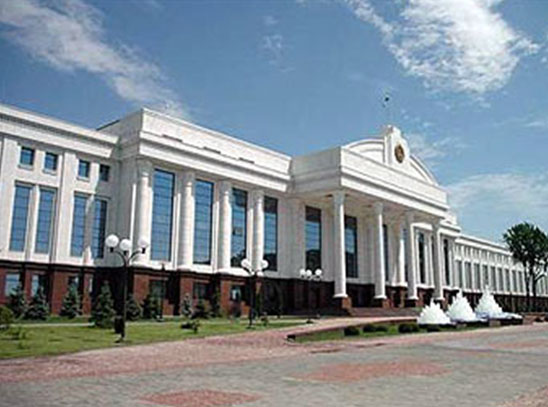
Senate is the Upper Chamber of territorial representation and consists of 100 members (senators). The Chairman of the Senate is Mr. Ilgizar Sobirov.
Members of the Senate are elected in equal quantity - six persons from each territorial entity (Republic of Karakalpakstan, provinces and the City of Tashkent) by secret ballot at relevant Joint Sessions of deputies of Zhokarghy Kenes of the Republic of Karakalpakstan, representative bodies of state authority of provinces, districts, cities and towns among their deputies. Sixteen members of the Senate are appointed by the President of the Republic of Uzbekistan from the most respectable citizens with large practical experience and special merits in the sphere of science, art, literature, industry and other spheres of state and public activity.
The term of Senate’s office - 5 years. To become a member of the Senate the person should be a citizen of the Republic of Uzbekistan, reached by the election day twenty-five years old and permanently residing in the territory of Uzbekistan for at least five years. The same person may not simultaneously be a member of the Senate and deputy of the Legislative Chamber.
Kengash of the Senate:
Kengash gathers between sessions in order to effectively organize the activities of the Senate, coordinate the work of committees, preparing proposals on the topical issues. Kengash is composed of the Chairman of Senate, his/her deputies and chairmen of the committees. Kengash adopts decisions within its competence and by majority vote of all its members.
Kengash is headed by Chairman of the Senate.
Committees of the Senate:
- Committee on Budget and Economic Reforms
- Committee on Legislation and Judicial-Legal issues
- Committee on Defense and Security
- Committee on Foreign Policy Issues
- Committee on Science, Education, Culture and Sport
- Committee on Agriculture, Water and Ecology
Jurisdiction of the Committees of the Senate:
- to give conclusion on the laws passed by the Legislative Chamber for approval;
- to develop its own initiative and on behalf of the Senate drafts of laws on matters relating to its conduct;
- to make proposals to Kengash of the Senate on the inclusion of laws to the agenda of the meeting or continuation of work on it or reject it with a reasonable justification;
- to give conclusions and suggestions on the draft of the State Budget of Uzbekistan;
- to request official documents and other expert opinions, statistical and other data from state authorities and other organizations;
- to create a working group to review laws introduced by the Legislative Chamber, attract representatives from government bodies and non-governmental organizations, academics, professionals and scientists, heads of business entities;
- to prepare proposals to amend or supplement of text of introduced laws of the Republic of Uzbekistan, as well as the decisions adopted by the Senate;
- to hear reports of heads of State bodies and government on their implementation of the laws of the Republic of Uzbekistan, regulations and decisions of the Senate committees.
Commissions of the Senate:
The Senate can create commissions for specific tasks. The Commission is created at the meeting of the Senate among a number of senators, which includes – chairman and members of the commission, and if necessary also deputy chairman of commission. The Senate makes a decision on establishing of a commission. Herewith, the Senate defines the goal and power of a commission.
Commission completes its activity after completion of tasks, or by the decision of the Senate. The form of its organization and activities is determined by the Rules of Procedure of the Senate. Nowadays, it has been formed one Commission - on the Regulations and Ethics.
The Commission on the Regulations and Ethics was formed by the Senate for the term of its office, and consist of 7 persons. The main tasks of the Commission are following:
- to assist Senators on the observance of the Senate’s ethics;
- to conduct outreach activities to promote political and legal culture of senators;
- to carry out preliminary consideration and preparation of questions on the ethics of senators;
- to monitor the observance of ethics by senators and prevention of its violations timely.
The Legislative Chamber (Lower Chamber) of Oliy Majlis of the Republic of Uzbekistan
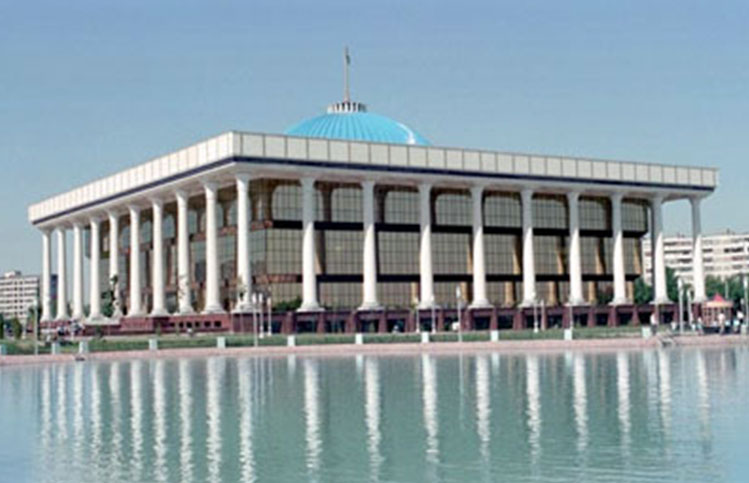
The Legislative Chamber consists of 120 Deputies elected by territorial constituencies on multiparty basis. The Speaker of the Chamber is Mrs. Dilorom Tashmukhamedova.
Kengash of the Legislative Chamber
In order to organize the work of the Chamber and to implement other powers that are stipulated by the Law, the Kengash of the Legislative Chamber was formed at its first session.
Structure of the Kengash:
The Kengash is composed of the Chairman of the Legislative Chamber, his/her Deputies, chairmen of committees, commissions (except interim ones), leaders of factions and blocs of the deputies.
Jurisdiction of the Kengash:
- introduces a motion on the agenda and procedures of the session of the Chamber;
- holds hearings of the reports of the committees and commissions on their work and information on implementation of the laws and other decisions of the Chamber;
- plans legislative activities;
- under proposal of the Chairman of the Chamber holds preliminary consideration of draft laws and other documents;
- analyses proposals and comments of the deputies given at the session of the Chamber and makes appropriate decision upon them;
- within the period between sessions, examines matters for giving consent to bring a deputy of the Chamber to an account in accordance with the law, as well as cases of his/her dismissal;
- appoints and dismisses the members of the Board of the Central Bank, Deputies Chairman of the State Committee on Environment of Uzbekistan;
- considers other issues related to the work of the Chamber and successful implementation of the powers of the deputies. On the issues related to its competence, the Kengash adopts decisions which are published in prescribed manner.
Committees of the Legislative Chamber:
- Committee on Budget and Economic Reforms
- Committee on Legislation and Judicial-Legal issues
- Committee on Labor and Social Affairs
- Committee on Defense and Security
- Committee on Foreign Affairs and the Inter-Parliamentary Relations
- Committee on Industry, Construction and Commerce
- Committee on Agriculture, Water and Ecology
- Committee on Science, Education, Culture and Sport
- Committee on Democratic Institutions, Non-governmental Organizations and Local Authorities
- Committee on Information and Communication Technology
The Government of the Republic of Uzbekistan
Cabinet of Ministers - The Government of the Republic of Uzbekistan is the executive power body of the Republic of Uzbekistan, ensuring guidance over effective functioning of the economy, social and cultural development, execution of the laws, and other decisions of Oliy Majlis, as well as decrees and resolutions issued by the President of the Republic of Uzbekistan.
The activity of the Cabinet of Ministers is based on the law of the Republic of Uzbekistan № 818-XII "On Cabinet of Ministers of the Republic of Uzbekistan" dated May 6.
The Cabinet of Ministers heads the system of bodies of state management and established bodies for economic management, and ensures their coordinated activity.
The Cabinet of Ministers is competent to consider all issues concerning state and economic administration in the Republic of Uzbekistan, included in its competence according to the legislation.
The Cabinet of Ministers has a right of legislative initiative.
The Cabinet of Ministers in its activity is guided by principles collective leadership, democracy and legality, accounting of interests of all nations and nationalities inhabiting the Republic of Uzbekistan.
The Cabinet of Ministers shall issue resolutions and ordinances in accordance with the current legislation. This shall be binding on all bodies of administration, enterprises, institutions, organizations, officials and citizens throughout the Republic of Uzbekistan.
The resolutions of the Cabinet of Ministers having normative character, are published in the Collection of the Orders of the Government of the Republic of Uzbekistan, and it the event of necessity through mass media for a immediate and nationwide promulgation.
The Cabinet of Ministers is the founder of the newspaper "Pravda Vostoka", and also co-founder of the newspapers "Narodnoe Slovo" and "Khalq Suzi".
Organization of activity of the Cabinet of Ministers
The procedure for the work of the Cabinet of Ministers is defined by the Regulation of the Cabinet of Ministers.
The activity of the Cabinet of Ministers is scheduled according to quarterly or semi-annual plans.
The sessions of the Cabinet of Ministers are held not less than once per quarter. The sessions are headed by the Chairman of the Cabinet of Ministers or on behalf of him by the Prime Minister of the Republic of Uzbekistan.
The Presidium of the Cabinet of Ministers composed of the Prime Minister and his Deputies acts as a permanent acting body of the Cabinet of Ministers. Upon the decision of the Chairman of the Cabinet of Ministers other members of the Government of the Republic of Uzbekistan can be included into the Presidium of the Cabinet of Ministers.
In the event of necessity the Cabinet of the Ministers and its Presidium can call ad hoc sessions to consider urgent issues.
The Prime Minister of the Republic of Uzbekistan heads weekly meetings with participation of Deputies the Prime Minister, the Chief of the Information and Analytical Department, the Chief of the Office to consider issues on organization of execution of the President’s orders and current activity of the Government.
Prime-Minister:
* allocates duties between the Deputies of the Prime- Minister with the subsequent approval by the Chairman of the Cabinet of Ministers;
* on behalf of the President of the Republic of Uzbekistan represents the Government of the Republic of Uzbekistan in the international relations and signs the intergovernmental treaties and agreements;
* makes decisions on state and economic management issues, which do not require a consideration at the sessions of the Cabinet of Ministers;
* on behalf of the Chairman of the Cabinet of Ministers considers other issues as well.

